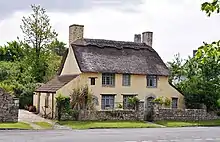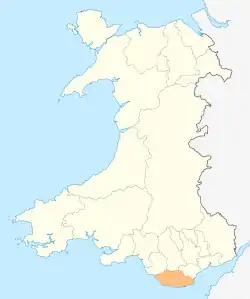Gileston
Gileston (Welsh: Silstwn) is a small Welsh village near West Aberthaw in Bro Morgannwg (the Vale of Glamorgan) on the coast of South Wales.
Gileston
| |
|---|---|
 St. Giles Church | |
 Gileston Location within the Vale of Glamorgan | |
| Principal area | |
| Ceremonial county | |
| Country | Wales |
| Sovereign state | United Kingdom |
| Postcode district | CF |
| Police | South Wales |
| Fire | South Wales |
| Ambulance | Welsh |
| UK Parliament | |
| Senedd Cymru – Welsh Parliament | |
Location
It is located some 15 miles along the coast from Cardiff and lies between Barry and Llantwit Major. Breaksea Point is the southernmost point of Wales.
Amenities & History

Barry Golf Club, The Leys, Gileston, (now defunct) was founded in 1897/8. In 1917 a new professional arrived at Barry Golf Club by the name of David James Rees. His four-year-old son, Dai Rees, learned the game there and went on to become a legend in world golf, captaining the British Ryder Cup team which beat America in 1957. The club and course was lost in 1957 when Aberthaw Power Station was built on the site.[1]
Gileston/West Aberthaw beach overlooking Limpert Bay has a number of pillboxes which still stand from World War II. It has the arable farm of the Thomas family who have farmed the surrounding land for over 100 years.
The village is tiny and previously consisted of little more than the church and the Gileston Manor. In 1771 the Bishop of Llandaff recorded that the population consisted of the rector and his family (who was also the squire of the manor house); a farmer, his wife, son and four servants; an old man and an old woman.[2]
Gallery
 Gileston Road coming from St Athan looking across the B4265 road towards Gileston (see google map)
Gileston Road coming from St Athan looking across the B4265 road towards Gileston (see google map) Meadow
Meadow Central village roundabout
Central village roundabout Gileston Farm
Gileston Farm Coast at Gileston
Coast at Gileston Coastal defense wall
Coastal defense wall Old barn
Old barn
References
- “Barry Golf Club”, “Golf’s Missing Links”.
- Francis, Keith A.; Gibson, William (2012), The Oxford Handbook of the British Sermon 1689–1901, Oxford University Press, ISBN 978-0198709770. Chapter 11 'Sermons in Wales in the Established Church' by John Morgan Guy
